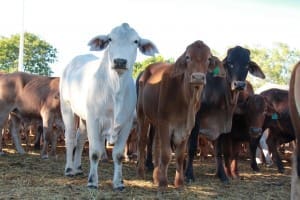Tightening cattle supplies have pushed the price of export feeder steers in Darwin to 220c/kg, amid concerns exporters may struggle to find enough cattle to fill Indonesian import permits for the final quarter.
Northern Territory Livestock Exporters Association chief executive office Ben Hindle told Beef Central on Friday that exporters would have no trouble filling the full 167,000 head permits for the current third quarter which ends in two weeks time.
However Mr Hindle and a range of other export industry sources contacted by Beef Central late last week agreed that satisfying Indonesian demand for feeder cattle in the fourth quarter could present a challenge.
Indonesia is set to release new import permits for the October to December quarter within the next two weeks.
The Indonesian Government declared its intention late last year to import 750,000 cattle for the entire 2014 year.
So far it has issued permits for 613,000 cattle across the first three quarters: 160,000 in Q1, 286,000 in Q2 and 167,000 cattle in Q3.
That leaves 137,000 cattle in the final quarter to make up the nominated 750,000 head annual target.
However some think that permit allocations for the final quarter may be even higher, with one source telling Beef Central that Indonesian importers have collectively applied for Q4 permits totalling 245,000 cattle.
The Q4 permits are being issued by the outgoing SBY Government. Australia will not get an indication as to how the new Jokowi Government will act towards cattle imports until it issues permits for the first quarter of 2015.
Regardless of the final number, Q4 permits this year are all but certain to dwarf the 46,230 head allocation initially issued for the corresponding period last year (‘initally’ because the quota system was abandoned just after Q4 2013 started).
The North is already drawing to the end of its annual dry season supply cycle.
Numbers of suitable feeder steers in North Queensland have by now largely been cleaned out following the export of a record 200,000 cattle from the port of Townsville in the past year.
Northern WA is also said to be close to sending its final shipment for the year, which leaves the Northern Territory as the primary source of supply for the final quarter.
Ben Hindle told Beef Central that the industry may struggle to supply more than 80,000 cattle in the final three months.
A colder than normal winter had knocked around the condition of the country and the remaining cattle in the north, while rising prices further south had also contracted the catchment area for viably-priced feeder steers for export.
Until recently exporters were sourcing cattle from as far south as Roma and Charleville. However, suitable live export weight steers in Roma were now attracting 220c/kg from local restockers and feedlots, the same price feeder steers are fetching in Darwin, before adding the cost of $200/hd road freight bill from Southern Qld to Darwin.
While the supply situation is clearly tightening, rising prices can also help to draw cattle from areas were none were previously thought to exist.
“It is surprising when somebody waves a fair bit of money around where they come from,” one trade source said.
Indonesian meat importers took to the local media late last week to urge consumers to prepare for an increase in the price of beef because of the tight supply situation in Australia and the strong demand that exists for Australian beef.
In an article in the popular Tempo newspaper last week the Indonesian Meat Importers Association (Aspidi) executive director Thomas Sembiring said strong competition for Australian beef from the United States and China inevitably meant Indonesia would also have to pay more to source Australian beef.
As a result Mr Sembiring said the price of imported beef would rise up to 30pc in the near future.
“Beef suppliers in Australia won’t serve buyers if they are not the regular customers,” he said.
Under the circumstances, Mr Sembiring said it was understandable that beef prices would climb. He added the earnings of importers would dwindle as they had to order beef at high prices. “Only the strong can survive,” he said.




You can waive the money around – but it is too late. If the bulls are too poor and half the cows are dead – don’t expect to fill your boats and feedlots just when you are all counting on a big windfall.All you “Industry sources and experts” should try pulling though breeding herds on hopeless prices for 2 and a half years and frightfull drought cost to boot! You experts have torn the guts out of the next two years production by your GREEED- so don’t you dare whinge about it now………………..!?%$#